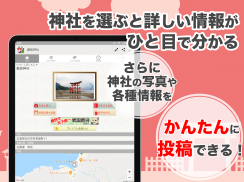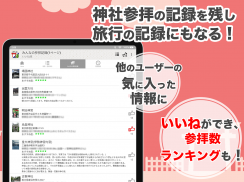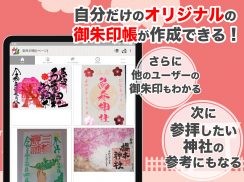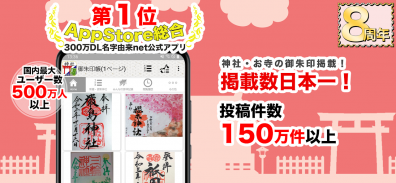












神社がいいね 御朱印帳・初詣の参拝記録 15万件の寺社情報

神社がいいね 御朱印帳・初詣の参拝記録 15万件の寺社情報の説明
AppStoreアプリ総合第1位
名字由来net公式アプリ(無料)
名字由来netアプリダウンロード300万件突破!!
御朱印・参拝投稿件数150万件突破!!
無料、簡単ワンタッチで15万件以上の寺社を一発検索!
簡単に近くの神社を探すことができ、地図でわかりやすく表示し、行き方も簡単にわかります。
もちろん神社の名前や住所などでも検索できます。
日本最大!15万件以上の神社・お寺情報を収録し、このアプリひとつで神社のことが何でもわかる!!
参拝の記録を残したり、いただいた御朱印をこのアプリの御朱印帳に残しておくと、旅行の思い出になる!
たくさん神社に参拝すると、ランキングに載るチャンスも!
神主(かんぬし)、巫女(みこ)になりたい方、神社ガール、御朱印ガール、御朱印男子、御朱印女子、神社男子、神社女子、歴女(レキジョ)、縁結びを求める皆さんにもおすすめのアプリです。
■アプリの特徴
・日本の神社情報を随時、更新・追加していき、神社情報の100%網羅を目指す「神社の百科事典」です。
・twitter,Facebookなどの各種SNSと情報連携し、神社の情報をすぐに共有できます。
・神社情報は手軽に追加、編集でき、ユーザー様がお持ちの情報を簡単に投稿できます。
・これまでに参拝した神社を「参拝記録」として写真付きで残すことができます。
・「御朱印帳」には、参拝した神社で頂いた御朱印を写真で記録することができます。
・神社アクセスランキングで、今注目トレンドの神社がひと目でわかります。
・気に入った参拝の情報に「いいね」ができるようになりました。
・ユーザー投稿ランキングで、参拝数の多い方や評価の高い方がわかります。
・地図から場所指定したり、有名な建物の周辺にある神社を検索できる「位置から検索」機能。
・気に入った神社、興味のある神社をお気に入りに登録できます。
・よく使う検索条件や、詳細な検索条件をお気に入り検索条件に保存できます。
・修学旅行の班別行動など決める際に大変便利です。
・日本の伝統文化に根ざしたアプリ。
※一部プレミアム会員機能
■神社とは
日本の神道において神様を祀っている施設のことです。
日本人は古来より、生活を通じ神様を尊敬することを常としてきました。○○の命(みこと)のみならず、山の神、海の神など、祀られている神様が非常に多様であることも特徴です。
森羅万象のすべてに神が宿る、八百万の神という考えが根底にあります。
神社とは、一切の災厄を祓い、家内安全、福徳円満,商売繁盛などを招かれますよう御祈願し、参拝、お祓いする方が多い場所です。
縄文や弥生、大和、飛鳥、奈良、平安、鎌倉、室町、戦国、江戸、明治、大正、昭和時代など、歴史があり、家にはお札や神棚を置きます。
神社建築には、伝統的な和風の技法が見られます。
神社で行う御祈願や御祈祷では次のようなものがあります。
初宮詣・七五三・交通安全・新車祓・家内安全・恋愛成就・業務安全・商売繁盛・旅行安全・合格祈願・厄祓(厄除祈願)・子宝・安産祈願・病気平癒・必勝祈願・八方除け・成人祝・命名・長寿祝・結婚式・金運や開運などの諸祈願、その他です。
神宮(伊勢神宮)のご祈祷では、皇室の弥栄・国家安泰・五穀豊穣や神恩感謝、家内安全・身体健全・商売繁盛・事業繁栄・安産祈願・お宮参り・学業成就・交通安全・厄祓い・除災招福・心願成就・病気平癒などがございます。
神社に依頼し、行う御祈願や御祈祷では次のようなものがあります。
地鎮祭・上棟祭・開通式・除幕式・火入れ式・竣工祭・新宅祭・宅神祭・開店、閉所清祓・進水式操業・安全祭やその他です。
神社には、年度ごとに初めて収穫された稲穂の豊作感謝の意味として「初穂料」が奉納されています。
「のし袋」には「御初穂」「御初穂料」「玉串料」等と記載します。参拝時にはお賽銭をお納めします。
「八方」とは、北(子「ね」)、東北(艮「うしとら」)、東(卯「う」)、東南(巽「たつみ」)、南(午「うま」)、西南(坤「ひつじさる」)、西(酉「とり」)、西北(乾「いぬい」)のことです。
古来からこの八方位を基本として陰陽五行、十干十ニ支、九星等配し、住居、方角、運勢等の吉凶を判断し、八方除けとします。
地球や宇宙、太陽、月、星、天体、惑星、衛星の位置関係、太陽暦や太陰暦が関係する場合もあります。 日本全国には富士山信仰などもあります。
日本には一年を通じ、神社での年中行事があります。
初詣、七草、鏡開き、14日年越し、小正月、節分、初午、針供養、ひな祭り、彼岸、社日、春祭、端午、夏越しの祓い、七夕、精霊祭、灯籠流し、重陽節、十五夜、十三夜、えびす講、十日夜、年忘れ、正月事始、煤掃き、松迎え、年越しの祓、年越(大晦日)
パワースポットとは、地球に点在する特別な場所のことであり「エネルギースポット」です。
パワースポットの多くは人を癒す「水」とされ、最もエネルギーがある場所とされています。多くの神社が水にまつわる場所に存在しています。
・有名神社
北海道神宮、姥神大神宮、岩木山神社、駒形神社、鳥海山大物忌神社、鹿島神宮、宇都宮二荒山神社、日光二荒山神社、一之宮貫前神社、氷川神社、氷川女體神社、秩父神社、玉前神社、洲崎神社、安房神社、小野神社、寒川神社、天津神社、居多神社、度津神社、彌彦神社(御神廟)、彌彦神社、射水神社、二上射水神社、気多神社、高瀬神社、雄山神社(峰本社)、雄山神社(中宮祈願殿)、雄山神社(前立社壇)、石部神社、白山比咩神社、氣比神宮、浅間神社、諏訪大社、飛騨一宮水無神社、南宮大社、三嶋大社、三嶋大社(三島大社)、富士山本宮浅間大社、事任八幡宮、小國神社、真清田神社、大神神社、砥鹿神社、都波岐神社・奈加等神社、椿大神社、伊射波神社、敢国神社、賀茂別雷神社、賀茂御祖神社、籠神社、片埜神社、坐摩神社、坐摩神社、住吉大社、住吉大社(住吉大神宮)、枚岡神社、伊和神社、出石神社、粟鹿神社、伊弉諾神宮、伊太祁曽神社、宇倍神社、熊野大社、出雲大社、物部神社、水若酢神社、由良比女神社、中山神社、吉備津彦神社、石上布都魂神社、安仁神社、吉備津神社、素盞嗚神社(戸手)、厳島神社、玉祖神社、住吉神社、一宮神社、天石門別八倉比売神社、上一宮大粟神社、大麻比古神社、田村神社、大山祇神社、土佐神社、筥崎宮、博多住吉神社、高良大社、与止日女神社(川上)、千栗八幡宮、海神神社、八幡宮神社、興神社、天手長男神社、阿蘇神社、西寒多神社(寒田)、柞原八幡宮、宇佐神宮、三宅神社、都農神社、枚聞神社、新田神社、鹿児島神宮、益救神社、波上宮、香取神宮、建部大社、気多大社、鹽竈神社、明治神宮、護国神社、靖国神社、八坂神社、櫻木神社
■神社巡りも各種収録
伊勢神宮(神宮125社)、全国の一之宮、令制国の総社、延喜式内社、国史見在社、二十二社、建武中興十五社、内務大臣指定護国神社、勅祭社、別表神社、東京十社
――――――――――――――――――――
■お城の情報が欲しい方へ
姉妹アプリ「お城がいいね」をお使いください。
https://play.google.com/store/apps/details?id=net.oshiro_iine.oshiro
――――――――――――――――――――
■お問い合わせについて
いつもレビューにて貴重なご意見・ご感想ありがとうございます。運営一同、拝見させていただいておりますが、アプリに関するお問い合わせ・不具合情報などがございましたら、以下よりご連絡いただきたく思います。
http://www.recstu.co.jp/contact_app.html
よろしくお願いいたします。
――――――――――――――――――――
■名字由来netについて
日本の名字(姓)の数は、苗字研究家であり文学博士丹羽基二氏著の「日本苗字大辞典」によると30万件弱と紹介されています。
約30万件弱あるとされる名字において、名字由来netは日本の全人口の99.04%以上の名字を網羅し、「名字由来」における膨大な情報量を誇る「情報量No.1」アプリです。
■備考
神社がいいねアプリは、ネットワークに繋がっている状態で動作します。
――――――――――――――――――――
神社がいいね・お寺がいいね Webサイト https://jinja-bukkaku.net (ユーザー数No.1 2013年から絶賛公開中!!)
名字由来net Webサイト https://myoji-yurai.net
twitter http://twitter.com/myoji_yurai
facebook http://www.facebook.com/298141996866158
























